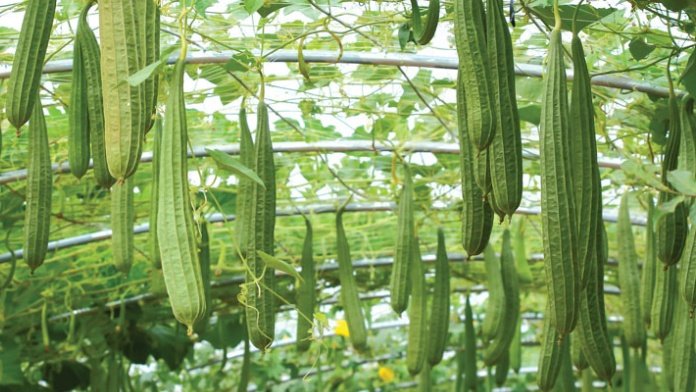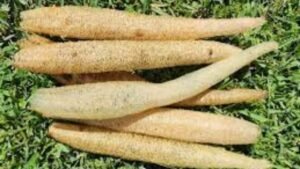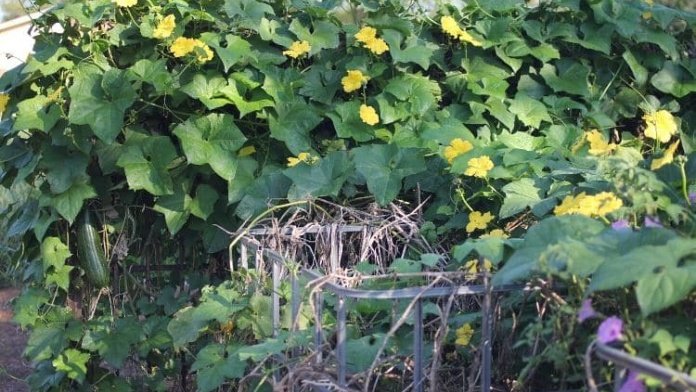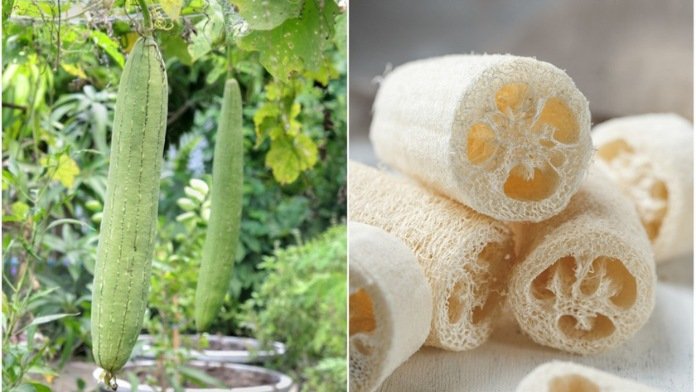
Luffa (Luffa aegyptiaca), often called “loofah,” is a fast-growing vine that produces gourds with large yellow flowers and attracts bees and butterflies. Loofah is native to Asia and grows best in warm climates, acidic soil, and at least six hours of sunlight.
The unique fruits of Lafa Lau are eaten or dried to be used as natural sponges. They take 90 to 120 days to mature and up to 200 days for sponges until they are ready to harvest.
In warmer climates, they can be planted directly into the ground, but in cooler regions, or if you want to bring them forward in the season, they can be grown under cover for extra protection. Read more tips for pruning luffa seedling vines.
What is the Loofah Plant Vine?
Loofah is a unique summer squash that is edible and useful as a sponge. The vine produces fruits that can be eaten raw or cooked when young but become large and fibrous when ripe. The ripe fruit can be peeled, dried, and seeded as a biodegradable sponge for personal care or cleaning.
The rough-textured scrubs are derived from loofah, the dried fiber from the vegetable of the same name. Luffa or loofah (botanically Luffa aegyptiaca) is a creeping member of the gourd, zucchini, and gourd family, Cucurbitaceae. Centuries ago, European settlers brought the loofah plant to this country.
Types of Luffa
Luffa aegyptiaca, also called smooth luffa or spongy guard, is most commonly available from seed companies. Common varieties include: ‘Smooth Boy,’ ‘Smooth Beauty,’ and ‘Southern Conqueror.’
There are two other species of loofah:
- Angular loofah (Loofah acutangula) is also known as Chinese okra, dishcloth guard, or fluted loofah. Its unripe fruit is popular in Asian cuisine. Common varieties include ‘Lucky Boy,’ ‘Hybrid Green Glory,’ ‘Summer Long,’ and ‘Hybrid Asian Pride.’
- Ball loofah (Loofah operculata): Also used as a fibrous sponge-like Loofah aegyptiaca.
How and When to Plant Loofah Plants
Due to the long growing season required to produce mature fruits, it is recommended that loofah be planted as soon as possible. Starting seeds indoors is recommended for those who live in cooler climates. In warmer climates, plants can be planted directly into the ground after the soil has warmed and the danger of frost has passed.
Loofah Plant Care Tips
Light
Direct sunlight is crucial for the excellent growth of Lofah plants. Too little sun will produce large vines with lots of leaves, but the flowers (if they occur) will fall just before or immediately after they open.
Soil and Water
These giant vines need healthy, nutrient-rich soil and plenty of moisture. Before planting in the spring, amend the soil with compost, manure, or other organic matter and feed throughout the season. Water regularly, and don’t let your plants dry out completely.
Temperature and Humidity
Native to tropical and subtropical regions, loofah plants prefer warm environments and thrive in humid conditions. They cannot tolerate cold temperatures, and growth stops when it is too cold. Likewise, they cannot survive freezing temperatures, and frost will damage or kill the vines.
Fertilizer
Apply compost or fertilizer in the fall before spring planting, then continue to fertilize the plants throughout the growing season. A high-nitrogen mixture can be used when the vines are young but should be changed to a high-phosphorus fertilizer as the plants mature.
Pruning
- Prune for a lean and bountiful loofah crop with appropriate spring pruning.
- Prune loofah in spring to align with its growth cycle.
- Pruning is best done in the morning with sharp and sterile scissors.
- Thin and shaped for health, fruit of ample size and controlled growth.
Do Luffas Need Pruning?
Luffa vines don’t need to be pruned, but they can help young plants produce more vines and encourage stronger stems for fruit production.
Growing lapa gourd is easy if you have a very long growing season. They mature for up to 200 frost-free days and can develop numerous stems filled with heavy fruit up to 2 feet tall (61 cm). Growing vines requires a lot of training and a sturdy trellis system. These vines can reach 25 feet (8 m) or more in late season.
Fortunately, early pruning of luffa plants will help keep the length to a manageable size and help train the stems—there is no need to trim the loofah unless you toss it.
Harvesting Loofah for Sponges

Towards the end of the season, loofah vines will naturally begin to die back. In dry climates, the fruits can be left on the vine to dry, turning green to yellow and eventually light brown.
In humid areas with high rainfall, the fruits should be removed and brought indoors to dry as soon as the leaves turn yellow.
Always harvest fruit before the first frost. When completely dry, the fruit’s skin becomes brittle and can be easily removed by hand, revealing the spongy interior.
Harvesting Luffa for Eating
Lofah can be cut and eaten in the same way as zucchini or cucumber. Pick the fruit when it is still young, green, and tender. Generally, fruits less than two inches in diameter are fibrous and best eaten before pith. Use a sharp knife or scissors to remove the fruit from the vine without damaging the fruit skin.
Pests and Problems
Like other cucurbits, loofah plants are susceptible to powdery mildew. Avoid splashing water on the leaves as much as possible, and provide enough space around the plant for good air circulation.
How to Propagate Loofah Plants
Male and female flowers look similar, but male flowers grow on longer stems and are usually the first to appear. They bloom for a day and then fall off. The female flowers are borne on a short stem (peduncle) but are ovoid like the fruit.
Here’s how to hand pollinate:
- Use a small paintbrush or cotton swab to transfer pollen from the male flower to the female flower, or gently rub the yellow hair-like structures of the male flower into the center of the female flower.
- Repeat for two or three days.
- Fruit formation should begin immediately after pollination.
- Shoot the Loofah
- Lofah seed germination rates vary widely, from 50% to 80% under ideal planting conditions. Some seeds may take longer than others from the same lot. It could be weeks. This usually takes seven to 14 days, but it can take four or five days for fresh seeds under ideal conditions.
How to Make loofah Bloom

The Month of Flowers
Loofah usually blooms in June or after about 90 days in the ground. Loofah flowers are short-lived and bloom for about a day until they fall off.
How do Loofah Flowers Look and Smell?
Loofah flowers are yellow and look like pumpkin flowers. Male flowers are usually united, while female flowers are solitary and look like small fruit bodies before blooming. They are lightly scented and typically bloom at night.
How Do we Encourage More Blooms?
The addition of nitrogen and phosphorus to fertilizers is directly related to producing male and female flowers. Adding more phosphorus to the fertilizer mix encourages more female flowers to make.
Loofah Care After Flowering
After the flowering period and fruit start to form, remove the remaining flowers to divert the plant’s energy away from flower production and towards further fruit growth.
Dead Luffa Flowers
Dead flowers that do not fall naturally. If your loofah plant has already started producing fruit, divert your plant’s energy to growing those fruits and removing new buds.
Common Problems with Loofahs
Luffa plants are easy to grow but take six to seven months to grow, mature, and dry on the vine.
Yellowing of Leaves and Stems.
Irrigation problems are the leading cause of the yellowing of plants. When loofah plants are overwatered, the roots cannot absorb more water due to oversaturation. Likewise, a submerged plant needs more water to thrive.
Luffa Fruit Turns Brown.
Luffa fruits start green but mature and turn brown. If you eat young fruits, choose them in the green stage. The brown color is suitable for growing loofah fruit for sponges. Pick them all off the vine before the first frost.
Fruit does Not Grow
If your Lafaa plant is blooming but not starting to produce fruit, it may need more female flowers, or your flowers need to be pollinated. Increase the production of female flowers by adding a phosphorus-rich fertilizer or, if bees don’t reach your flowers, hand pollinate them.
Conclusion
The loofah or loofah plant is a type of gourd. Although not strictly a vegetable, it can be eaten young. The mature plant is dried and used as a back scratcher or scrubber. The vine it grows on is similar to the cucumber vine.
When picking loofah seeds, choose mature, healthy seeds that are dark and hard, like watermelon seeds. In warmer climates, they can be planted directly into the ground, but in cooler regions, or if you want to grow them early in the season, they can be grown under cover for extra protection.
FAQ
How Big will My Loofah Get?
Loofah vines should have a strong trellis system for climbing. Vines like to grow tall and do well on trellises 6 to 10 feet (2 to 3 m) high. The vine can exceed 9 m (30 ft) in length.
How do you Care for Luffa Seedlings?
Loofahs prefer total sun exposure, plenty of water, and well-drained soil. Fertilizing these plants once a month would help, but they are relatively low maintenance. Fast-growing vines and heavy squashes need a sturdy trellis and a fence.
How do you Prune Luffa Vines?
Trim the loofah with a very sharp and clean cutting tool. Wait until the plant has at least four stems and cut all the first stems back to the main stem. Train the stems up the trellis or fence and let them grow. The male that pinches the first flower.
What can you Plant Next to Luffa?
Loofah can be planted between peas, beans, sweet corn, and onions. But remember to avoid potatoes! Potatoes are not ideal for companion planting; both plants may need more overall success.
RELATED POSTS
View all


